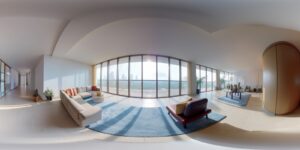Introduction
As the world embraces sustainable practices, the integration of renewable energy sources into our daily lives has gained unprecedented momentum. In the realm of modern workspace design, an intriguing trend is emerging – the integration of bifacial solar panels with contemporary office furniture. This symbiotic fusion of technology and design is redefining the way we perceive commercial furniture. In this article, we explore why bifacial solar panels are becoming an integral part of modern office furniture, heralding a new era of sustainable workspaces.
Looking for: high-quality and stylish Modern Office Furniture.
Understanding Bifacial Solar Panels
Bifacial solar panels are a revolutionary leap in solar technology. Unlike traditional solar panels that only capture sunlight on one side, bifacial panels harness energy from both sides. These panels are constructed with transparent backsheets, allowing them to capture reflected sunlight from surfaces below. This innovative design enhances energy generation and efficiency, making bifacial panels an ideal choice for integration in various applications.
Integration in Office Furniture
The integration of bifacial solar panels in office furniture marks a groundbreaking shift. Imagine desks, workstations, and seating areas equipped with solar panels seamlessly embedded into their surfaces. These panels serve a dual purpose – they charge electronic devices and power lighting systems, effectively transforming everyday furniture into energy sources.
Benefits for Workspaces
The adoption of bifacial solar panels offers a myriad of benefits for workspaces. From an economic perspective, the generation of solar energy translates to reduced electricity costs, contributing to overall operational efficiency. Additionally, embracing solar-integrated furniture aligns with sustainability goals, reinforcing an organization’s commitment to environmental responsibility.
Enhancing Flexibility and Mobility
One of the intriguing aspects of solar-integrated furniture is its mobility. Portable Best Modern Office Furniture solutions equipped with bifacial solar panels empower employees to work outdoors while staying connected. This level of flexibility resonates with modern workstyles, catering to those who seek a dynamic and ever-changing work environment.
Design and Aesthetics
The integration of technology often raises concerns about design aesthetics. However, bifacial solar panels have been ingeniously designed to blend seamlessly with modern office furniture. Manufacturers are prioritizing sleek and functional designs that integrate solar technology without compromising the overall visual appeal of the furniture.
Technological Challenges and Innovations
The implementation of solar-integrated furniture isn’t without its challenges. Efficient utilization of bifacial panels requires overcoming shading issues and optimizing energy capture. However, ongoing research and development are paving the way for innovative solutions that maximize the potential of this technology.
Employee Engagement and Awareness
The integration of solar panels in furniture serves as more than just an energy solution – it’s a powerful tool for raising environmental awareness among employees. Solar-powered workstations encourage eco-conscious behavior by reminding individuals of the sustainable energy source powering their devices.

Case Studies and Success Stories
Several forward-thinking companies have already embraced solar-integrated furniture. Their experiences highlight the positive impact on workspace dynamics and energy consumption. These success stories serve as inspiration for other organizations looking to adopt similar practices.
Potential Applications Beyond Offices
The concept of solar-integrated furniture extends beyond office spaces. Public areas, parks, and outdoor settings can benefit from solar-powered seating and charging stations. This not only enhances user experience but also contributes to sustainable urban planning and community engagement.
Considerations for Implementation
Implementing solar-integrated furniture requires careful planning. Factors such as available space, installation logistics, and return on investment need to be considered. However, the long-term benefits, both in terms of energy savings and environmental impact, make it a worthwhile endeavor.
Addressing Concerns and Misconceptions
As with any innovative technology, there are concerns and misconceptions surrounding solar-integrated furniture. Durability, maintenance, and potential challenges need to be addressed transparently to ensure the longevity and practicality of such designs.
Environmental Impact and Future Prospects
The integration of bifacial solar panels in commercial furniture contributes to the reduction of carbon emissions and the utilization of clean energy. As this trend gains momentum, it has the potential to revolutionize the way we approach workspace design, and even inspire further innovation in sustainable technology.
Conclusion
The integration of bifacial solar panels with modern office furniture signifies a transformation in both workspace design and our approach to sustainable energy solutions. As organizations increasingly prioritize environmental responsibility, the marriage of technology and design paves the way for a greener future. Bifacial solar panels, seamlessly integrated into furniture, not only redefine the concept of power but also empower individuals to work in harmony with nature.
Searching for: online Modern Office Furniture.
FAQs
1. How do bifacial solar panels work, and how are they different from traditional panels?
Bifacial panels capture sunlight from both sides, utilizing reflected light to enhance energy generation, distinguishing them from traditional solar panels.
2. What advantages do solar-integrated furniture solutions offer for workspaces?
Solar-integrated furniture offers energy efficiency, cost savings, sustainability benefits, and the promotion of eco-conscious behavior among employees.
3. Can solar-integrated furniture be adapted to outdoor spaces beyond offices?
Yes, solar-integrated furniture can be extended to public spaces, parks, and outdoor settings, offering sustainable charging solutions and enhancing user experience.
4. Are there concerns about the durability and maintenance of solar-integrated furniture?
Addressing concerns transparently, solar-integrated furniture manufacturers prioritize durability, maintenance, and long-term practicality of their designs.
5. How do solar-integrated furniture solutions contribute to environmental sustainability?
Solar-integrated furniture reduces carbon emissions and dependency on non-renewable energy sources, contributing to a greener and more sustainable future.





